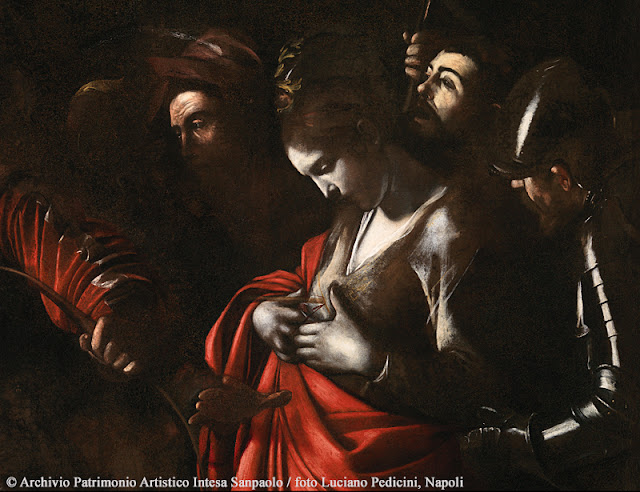
Caravaggio's innovative art and immoderate life remain a source of enduring fascination. Indeed, it is no accident that they are presented as the inspiration for the protagonist of the new Netflix show, Ripley. Caravaggio's realistic portrayal of saints and sinners and his frequent undertones of sensuality and violence tease his audience just as his extraordinarily tempestuous life intrigues them. This latest bijou exhibition focuses on the master's last known work, The Martyrdom of Saint Ursula (1610) which was only definitively attributed to him in 1980. That painting which is on loan to The National Gallery is displayed in the context of the collection's own Caravaggio, Salome receives the Head of John the Baptist (1609-1610). Both pieces focus on particularly grisly acts and the emotional responses to them of the principals and onlookers. In the former it is notable that Caravaggio has painted himself into the story. It becomes tantalising to try to read his expression and to attempt to fathom the rationale for his self-presentation. In the latter work, it is the rugged face of the assassin which draws the viewer's attention as it is contrasted to a distressed Salome turning away from the ruin that she has wrought. One cannot help speculating how this act and these reactions might resonate for the artist who himself was accused of murder. The exhibition is rounded out by the letter that led to the attribution of The Martyrdom of Saint Ursula (1610) and by a couple of 17th century texts which recount the harrowing death of the artist. This show provides an insightful glimpse into the complex psychology and masterful creativity of the enigma that is Caravaggio. It's also a suitably memorable part of the celebration of The National Gallery's bicentenary.
Rated: ★★★★
Reviewed by J.C.
Image: Detail from Michelangelo Merisi da Caravaggio, Martyrdom of Saint Ursula, 1610. Intesa Sanpaolo Collection, Gallerie d’Italia Naples © Archivio Patrimonio Artistico Intesa Sanpaolo / photo Luciano Pedicini, Naples
When, Where, Getting there:

%20and%20Nicola%20Coughlan%20(Pegeen%20Mike)%20in%20The%20Playboy%20of%20the%20Western%20World%20at%20the%20National%20Theatre.%20(c)%20Marc%20Brenner%200003.jpg)





,%20Marianne%20Jean-Baptiste%20(Kate%20Keller),%20Hayley%20Squires%20(Ann%20Deever)%20and%20Paapa%20Essiedu%20(Chris%20Keller).%20Photo%20Jan%20Versweyveld.jpg)
%20and%20Clive%20Owen%20(Alfie)%20in%20End%20at%20the%20National%20Theatre.%20Photographer%20Marc%20Brenner%2003422.jpg)
%20Johan%20Persson.jpg)
